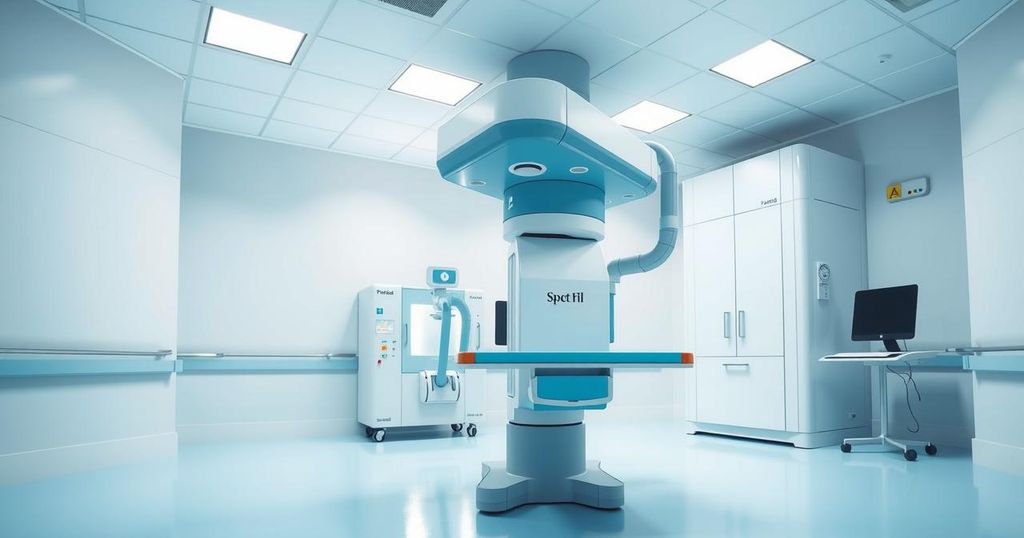Global news
BRAZIL, BRAZILIAN NATIONAL NUCLEAR ENERGY COMMISSION, CLAUDIO TINOCO MESQUITA, CLINICAL TRIALS, ENRIQUE ESTRADA LOBATO, IAEA, IAEA DIVISION OF HUMAN HEALTH, LIFE EXPECTANCY, MEDICINE, NITEROI, PANDEMIC, PUBLIC HEALTH, RADIOLOGY, RESEARCH, RIO DE JANEIRO, SOUTH AMERICA, UNIVERSIDADE FEDERAL FLUMINENSE, UNIVERSITARIO ANTONIO PEDRO
Fatima Khan
0 Comments
Enhancing Heart Diagnosis in Brazil: The Impact of a New SPECT Camera
The IAEA’s donation of a SPECT camera to a Niteroi hospital has doubled heart scan capacity, benefiting over two million underserved people. This advancement addresses the urgent medical needs related to cardiovascular diseases, which are prevalent in Brazil. The upgraded technology enhances efficiency and allows for expanded training opportunities for medical professionals.
The donation of a SPECT camera by the International Atomic Energy Agency (IAEA) has significantly enhanced heart diagnosis capabilities in Niteroi, Brazil. This advancement has allowed a local hospital to double the number of heart scans conducted, ultimately benefiting over two million underserved individuals in the surrounding communities.
Cardiovascular diseases remain the foremost cause of mortality worldwide, with Brazil particularly affected by heart-related ailments. While lifestyle changes are essential preventive measures, specialized tests like nuclear medicine procedures have become crucial for early detection, thereby reducing the mortality rates linked to heart failure.
Single photon emission computed tomography (SPECT) is a key nuclear medicine technique that utilizes gamma rays to generate three-dimensional insights into organ function. As noted by Enrique Estrada Lobato, a physician in the IAEA Division of Human Health, “In cardiology, SPECT tomography is standard to diagnose coronary artery disease and wall abnormalities,” which includes myocardial perfusion imaging (MPI), a critical test assessing blood flow to the heart muscle.
The Hospital Universitário Antônio Pedro (HUAP), the only public hospital in Niteroi with a nuclear medicine department, previously operated with a 12-year-old single-headed gamma camera, leading to prolonged wait times for patients amid growing demand. Claudio Tinoco Mesquita, head of the nuclear medicine department, remarked, “The old equipment served us well, but it could not deal with the increasing needs for exams in our region,” resulting in wait times exceeding eight months for over 600 patients on the list.
In response to IAEA audits conducted in 2013 and 2017, the Brazilian National Nuclear Energy Commission sought assistance from the IAEA for new equipment. Subsequently, a dual-head gamma camera equipped with IQ-SPECT was successfully installed at HUAP in August 2023.
The introduction of advanced technology has markedly improved efficiency, reducing MPI scan times from over 20 minutes to just 6 or 7 minutes, as Mesquita expressed his satisfaction, stating, “This donation changed everything.” The new camera has doubled the hospital’s operational capacity, enabling more than 1,000 additional patients to receive vital nuclear medicine procedures within the first ten months.
Furthermore, the upgraded equipment has expanded opportunities for training nuclear medicine professionals, allowing HUAP to initiate a new residency program for medical physicists who are integral to the examination process. Mesquita emphasized the significance of this success story, indicating, “The support from the IAEA had a transformative role in our practice and a positive impact in the lives of many patients.”
The IAEA continues to promote nuclear and radiation medicine to combat noncommunicable diseases, including cardiovascular conditions, while also implementing quality management systems to enhance safety and service quality in nuclear medicine.
The donation of a SPECT camera by the IAEA has greatly improved heart diagnosis capabilities in Niteroi, Brazil, effectively doubling the hospital’s scanning capacity and reducing patient waiting times. This innovation not only advances early detection of cardiovascular diseases but also enhances training opportunities for medical professionals, showcasing the transformative impact of international cooperation in healthcare.
Original Source: www.miragenews.com




Post Comment